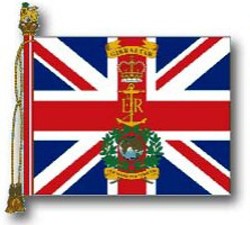The Colours
The ‘Colours’ as they are know were first presented by William, Duke of Clarence, who later went on to become George IV, in 1827. A ‘Stand of Colours’ consists of, the Queens and Regimental colours. The history of the ‘Colours’ can be dated as far back as the Stone Age when men painted their skins different colours as recognition in battle. This later progressed to knights of old having their standards painted on their shields. In days gone by soldiers rallied by their standards rather than their leaders and the last phase of any battle was normally found around the ‘Colour’ of the losing side. At sunset on the eve of a major battle the ‘Colours’ would be paraded before the men to give the soldiers heart for the coming battle. This ceremony has, in present days, come to be known as ‘Trooping the Colour’. During this ceremony the colours are paraded before the particular Battalion which are trooping their ‘Colour’. This also stems from the fact that a soldier would grasp the corner of the ‘Colour’ when taking the ‘Oath of Allegiance’.
| |

The Queen’s Colour |
|
The Union Flag, in the centre of which is a foul anchor with the cipher of HM The Queen interlaced; above, St Edward’s Crown surmounted by a scroll inscribed ‘Gibraltar’; below, the globe surrounded by a laurel wreath, under which a scroll inscribed with the Corps motto ‘Per Mare Per Terram’. The cords and tassels are of gold interwoven with silks of the Commando’s colour which corresponds to the Commando lanyards worn by all ranks.
The Regimental Colours
A Blue Flag with a small Union Flag in the canton nearest the pike head, and the Cypher of HM The Queen surmounted by a St Edward’s Crown in the other three corners; centre embellishments are similar to the Queen’s Colour, except that the foul anchor is interlaced with the cipher of George IV and the Commando numeral appears below the motto. The cords and tassels are of gold interwoven with silks of the Commando’s colour which corresponds to the Commando lanyards worn by all ranks.
'History & Traditional Facts' Royal Marines Historical Society.
